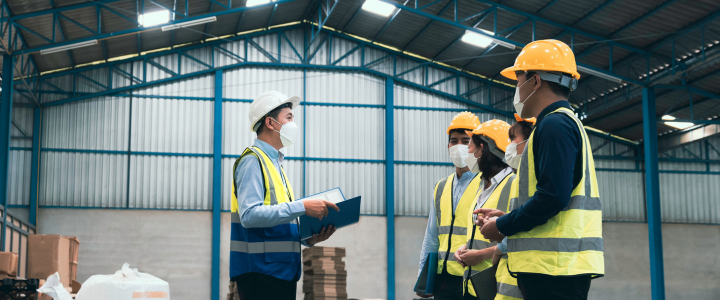So, how do you build a culture of safety in your organization? It’s about creating an environment where safety is not just a priority on paper but a shared value embedded in the fabric of your organizational culture. Let’s explore the steps that go beyond the surface, cultivating a lasting commitment to workplace safety.
What Is Safety Culture?
Safety culture refers to the shared values, beliefs, attitudes, and behaviors regarding safety within an organization. It represents the organization’s collective commitment to ensuring the well-being of its employees and creating a work environment where safety is a priority at all levels.
Key aspects of safety culture include:
- Communication: Effective communication channels for safety-related information are essential. This includes the transparent sharing of safety policies, incident reports, and ongoing safety updates.
- Accountability: Individuals and teams are accountable for maintaining a safe work environment. Accountability ensures that everyone understands their responsibilities and actively contributes to safety efforts.
- Consistency: Safety practices are consistent across all levels of the organization. There must be alignment between stated safety policies and day-to-day operations.
A positive safety culture not only helps workplace safety but also contributes to increased productivity, employee morale, and overall organizational success. It requires ongoing commitment, communication, and collaboration to create an environment where safety is not just a priority but an integral part of the organizational DNA.
How to Assess Your Current Safety Culture
To assess the current safety culture in your workplace, you can start by asking questions and listening to your colleagues. Encourage open conversations about safety, inquire about their perceptions, and understand how they approach safety in their daily tasks.
Additionally, consider conducting simple surveys or checklists to gather anonymous feedback on safety practices and concerns. Observing day-to-day operations and noting any safety practices or challenges can provide valuable insights.
Remember, the goal is to create a safe space for everyone to share their thoughts and experiences, allowing you to identify what’s working well and where improvements can be made. Regular communication and a collaborative approach will build a stronger safety culture within your team or organization.

Steps to Building a Work Culture of Safety
Building a strong safety culture in the workplace is a multifaceted process that requires commitment and involvement at all levels of the organization. Here are the essential steps to guide you in establishing and fostering a robust safety culture:
Demonstrate Leadership
Top executives must visibly and consistently demonstrate their dedication to safety by actively engaging in safety initiatives, communicating expectations, and setting a positive example for others.
Get Employees Involved
Actively encouraging employee participation in safety matters, including safety committees, hazard reporting, and decision-making processes, creates a collaborative environment where everyone contributes to maintaining a safe workplace.
Encourage Clear Communication
Establishing transparent avenues for safety information ensures that policies, updates, and success stories are regularly shared, reinforcing the importance of safety throughout the organization.
Enforce Safety Policies and Procedures
The development of clear and concise safety policies and procedures, aligned with industry standards, is imperative. Regular reviews and updates to reflect changes in the work environment or regulations help ensure that policies remain relevant.
Give Recognition and Rewards
Acknowledging safe behaviors and achievements, coupled with establishing positive reinforcement systems (like safety incentives), fosters a culture where safety is a shared responsibility.
Increase Risk Awareness
Creating a culture of risk awareness involves encouraging employees to identify and report potential hazards. Conducting regular risk assessments and transparently communicating findings to all relevant parties contribute to proactive risk management.
Take Accountability
Clearly defining roles and responsibilities related to safety and holding individuals and teams accountable for adhering to safety protocols and procedures establish a sense of responsibility and ownership.
Reporting and Investigation
Promoting a proactive reporting culture for incidents, near misses, or hazards is essential. Conducting thorough accident investigations to understand the root causes of incidents and implementing corrective actions contribute to a culture of continuous improvement.
Promote Ongoing Training and Education
Providing comprehensive safety training for all employees, emphasizing the significance of safe practices, and keeping them informed about new safety procedures and technologies are essential to building a safety-conscious workforce.

Sustain a Strong Safety Culture with Training
In partnering with a third-party safety consulting company, organizations can not only initiate a strong safety culture but also sustain it over the long term. Here’s how Safety By Design’s training programs can help:
- Customized Training Programs: Safety By Design tailors training programs to specific industries and job roles, ensuring relevance to the unique challenges each workforce faces. This customization ensures that employees receive training directly applicable to their daily tasks and responsibilities.
- Innovative Training Methods: Safety By Design embraces innovative online safety training methods, incorporating technology, e-learning modules, and virtual reality simulations. These modern approaches enhance engagement and effectiveness, making safety training a dynamic and interactive experience.
- Hands-On Learning Experiences: Practical demonstrations and hands-on learning experiences are integral to Safety By Design’s training philosophy. Allowing employees to apply theoretical knowledge in real-world scenarios makes the training more impactful and directly applicable to their work environment.
Contact Safety By Design today and take the first step towards creating a culture of safety.
Tags: safety consultant, workplace safety


